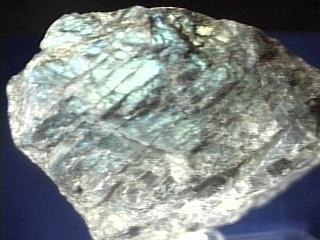
- Varieties of Feldspar
- Formation of Feldspar
- Sources of Feldspar
- Physical & Optical Properties of Feldspar
- Test and Identification of Feldspar
- Valuation and Buying Tips for Feldspar
The feldspar group of minerals is unusual among gemstones which are usually considered the rarest of objects, for as a group, feldspar is the most common mineral known to man. Although quartz is more abundant in the earth's crust than any single feldspar mineral, the feldspar group exceeds quartz in abundance. It is undoubtedly the most important rock-forming mineral group in nature. With the exception of the ultra basic rocks, such as peridotite (kimberlite), all crystalline rocks are rich in feldspar. However, despite the fact that it is a very common mineral, fine gem qualities of some of its varieties are very rare.
The mineralogist distinguishes two main types of feldspars: the POTASSIUM FELDSPARS and the PLAGIOCLASE FELDSPARS. The potassium feldspars are ORTHOCLASE and MICROCLINE. The plagioclase feldspars form a group within a group that varies in composition from ALBITE (ALL-bite), which is sodium-aluminium silicate, to ANORTHITE (an-OR-thite) which is calcium aluminium silicate. The intermediate members are delineated by the relative amounts of sodium and calcium in their compositions. Of this series, two members are significant in the gem world: (1) albite, which is often seen as a type of MOONSTONE and also in the form of SUNSTONE, and (2) LABRADORITE, which is useful as a gem material because of its interesting change of color.
The word feldspar is a rather recent one from the German "feldspath" translated the German world meant "feldspar", however, when it was first introduced into English literature, the "i" was dropped in error and the world for the mineral became feldspar. "Spar" is a word used by miners for shiny rock that cleaves easily; it has been applied to calcite, fluorite and gypsum, as well as to feldspar. It is derived from the Anglo-Saxon word "spaeth". Orthoclase was named from the Greek words for "right" and "cleavage" because its cleavage directions are at right angles. Microcline is the English spelling of the German word "mikrokin," which is from the Greek words meaning "small" and to incline, meaning that the cleavage planes are mutually inclined at an angle that differs slightly from a right angle. Albite was named for the fact that it is usually white, and the root word was the Greek "albus" meaning "white". The name plagioclase comes from two Greek words meaning "oblique" and "cleavage", because of the distinct divergence from a right angle of the angle between the two cleavage planes. Anorthite is derived from two Greek words meaning "not" and "upright," in reference to its triclinic symmetry. The Greek words meaning "small" and "cleavage" form the root for oligoclase, because it was incorrectly thought to have a less easy cleavage than albite. ADUIARIA (add-u-IAR-ee-uh), which is another name for moonstone, gets its name from the Adula Mountains, a group of mountains in the Swiss Alps. The word ANIAZONITE, a variety of microcline, was derived from the Amazon River in South America, although none is found in this region. Labradorite was named for the country of Labrador, where it was first found by Moravian missionaries in the eighteenth century; at that time it was called "labrador stone" or "labrador spar" Andesine and bytownite were also named after the places where they were first discovered: the Andes Mountains in South America and By town (now Ottawa) in Canada.
Moonstone, the most valuable of the feldspar gems, has been used for jewelry purposes for many centuries. In many areas of the world it is still believed to bring good fortune to its wearer. In ancient times it was supposed to arouse tender passions in lovers and give them power to read the future. In order for it to be effective as a means of determining one's personal future, it was supposed to be placed in the mouth when the moon was full. In India, moonstone is regarded as a sacred stone, it is displayed only on saffron cloth, for saffron is an especially sacred color our country.
Although amazonite has become a gemstone of importance from the viewpoint of the frequency of its use in inexpensive jewelry, there is little to suggest that it was known in antiquity. It is possible that it was used of course, but it has not been found among early Egyptian jewelry nor among the jewelry articles found in the records of slightly later civilizations.
Varieties And Trade Names

Moonstone or Adularia
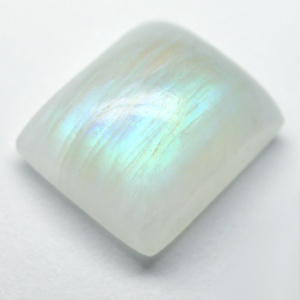
Moonstone is usually colorless to white, semitransparent to translucent, and characterized by a glowing light effect, the visibility of which is confined to a restricted angle of view. In almost every case it is a mixture of two or more types of feldspars. The moonstone effect, which is called ADUIARESCENE (ad-u-lar-ESS-ence), is caused by a concentration of the soda-type feldspar (albite) in oriented positions within the main mass of orthoclase. Some moonstones contain enough albite to have properties nearer those of albite than of orthoclase; on the whole, however, moonstone is regarded as a variety of orthoclase. Fine quality moonstone, with its floating, billowy, bluish light, is probably the most widely cherished among the feldspar gem materials. The finest qualities are semitransparent, whereas the poorer qualities are translucent. A white adularescence is less highly regarded than the light-blue type.
Since World War II, other colors and types of moonstone have made an appearance. These are semitransparent stones with fairly strong colors, particularly green and brown to almost black. Some exhibit a distinct chatoyancy: these have been called cat's-eye moonstones. Others display a second band at right angles to the first, forming a four rayed star. In each instance, the cat's-eye and star effects leave something to be desired in comparison to their corundum or chrysoberyl counterparts. These types of moonstone have been regarded largely as curiousities; they do not appear to be gaining any great amount of popularity.
Sunstone
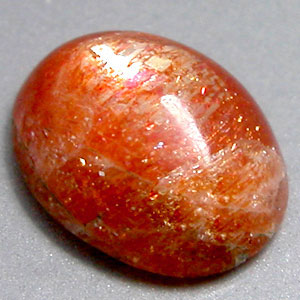
The finer qualities of sunstone, which is one of the two important and distinct types of albite, resemble moonstone very closely, except that the body color is golden and the floating light has a warm, shiny, golden adularescence . As a cabochon is turned about, the billowy sheen is seen to move about over the crest of the stone.
Aventurine
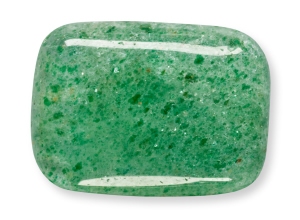
The characteristic appearance (ah-ven-chure-ESS-ence) of this type of albite serves readily to differentiate it from its close relative, sunstone. The presence of numerous tiny flakes or platelets of an included metallic mineral, such as hematite or goethite, gives rise to a reddish or golden spangled effect that is visible as the stone is moved. This phenomenal effect is imitated closely in glass by the popular goldstone, which is used widely in the costume-jewelry field. The curious fact that this variety of feldspar was actually named after the imitation is indeed interesting. History records that, in a glass factory on the Island of Murano, near Venice, a workman a accidently overturned a receptacle of copper filings into a pot of molten glass. The result was a material with a spangling of gold. They called this material by the Italian word "avventura" meaning "chance" or "accident". Goldstone, as made today, contains copper crystals, rather than filings. In due course, the-genuine varieties of both quartz and feldspar that exhibited this characteristic effect came to be known as aventurine; thus, the name of an imitation was permanently applied to genuine gemstones. A type of albite exhibiting a greenish to grayish-green body color with a silvery aventurescence has also been reported.
Labradorite
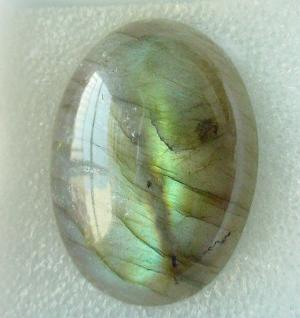
The most important gem member of the plagioclase group is labradorite, the chief attraction of which is its change of color that may be visible at one angle across the entire surface of the stone. This effect is created by light interference set up by thin plates of feldspar that result from repeated twinning. Repeated twinning is characteristic of the plagioclase feldspars. Large masses of labradorite display this effect, which is known as LABRADORESCENCE, often in a single color over large areas. This same feldspar species is occasionally found in a transparent yellow form that may be cut for collectors as a curiosity; it resembles pale citrine quartz, but is much more fragile and does not exhibit labradorescence.
Amazonite, or Amazon Stone
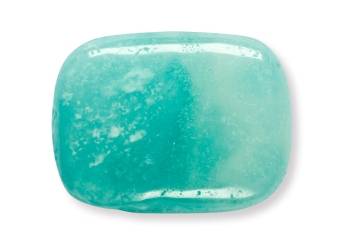
This type is a light green to light bluish-green variety of microcline feldspar. It owes its use as a gemstone to the attractiveness of its color and its resemblance to jadeite; in fact, it has been called "Colorado jade" and "Pikes Peak jade", incorrectly. The appearance of amazonite is distinctive, in that it has grid like mottled green and white patterns and a faint sheen.
Formation of Feldspar

Feldspars, the most important of the rock-forming minerals, are integral constituents of almost every igneous rock; in fact, it is the color of the feldspar that usually determines the color of the igneous rock of which it is a part. For example, orthoclase, which makes up about 90% of the volume of a granite, makes the rock pink when it is pink and white when it is white. A lower silica content usually means a darker feldspar and a darker rock. In general, the richer the silica content of an igneous rock, the higher the percentage of feldspar of the potassium types, orthoclase or microcline. The lower the silica content, the darker the rock and the higher the proportion of feldspar in the plagioclase family; in fact, the lower the silica content, the greater the shift in the plagioclase content toward the calcium or anorthite end. The feldspars also crystallize as a vein mineral, are important constituents in many metamorphic rocks, and are found as grains in sedimentary rocks.
Gem quality moonstone is found in cavities in gneiss and crystalline schists, less commonly in ore-mineral veins, and as pebbles in gravels. The moonstone effect is the result of an intimate intergrowth of feldspar of the albite type with the orthoclase. This forms in parallel layers and gives rise to the characteristic adularescence. (Note: This optical phenomenon is called SCHILLER or SCHILLERlZATION by mineralogists.) X-ray studies indicate that at high temperatures the albite molecules are diffused through the orthoclase, but that as the temperature drops an exsolution process leads to the separation of the two feldspars into layers representing the two different structures and compositions.
The differences in refractive Index give rise to reflections that are essential to the production of the floating light effect that characterizes moonstone. The thinner the layers of albite and orthoclase, the bluer and more attractive the weight effect.
Labradorescence is also caused by a layered structure, but in this case the layers are caused by repeated twinning. The thin layer's, each with a different orientation than the two in contact with it, lead to the light interference effects expected from thin films of material of slightly different R.I. The uniformity of thickness of a layer over wide areas leads to a uniformity of color over the broad area for any single angle of observation.
The peculiar appearance of amazonite is also a consequence of its twinned structure, but in this case sets of twins nearly at right angles to one another. Microcline is the usual feldspar in pegmatite dikes, although very rarely is it the attractive green color.
Sources of Feldspar

Historically, the most important source of moonstone has been Ceylon, where it is found in many areas as rolled, rounded pebbles in the gem gravels with spinel and corundum. In addition, it occurs in dikes in several places on Ceylon, notably in the central and southern provinces. Perhaps the major producer on the island in point of total production is that in which angular fragments are winnowed from a kaolin clay. Kaolin is the pure china clay that is formed from the decomposition of feldspar. In recent years, the finest moonstone has come from the rich gem gravels of the Mogok area of Upper Burma. Other, less important, sources include Madagascar; Tanganyika; in the vicinity of Rio de Janeiro, Brazil; Western Australia; Colorado; Virginia; and California. The first source, as mentioned previously, was in the Adula Mountains in Switzerland.
In all of the major sources, primitive mining methods are used. Moonstones are picked from wet gravels when the rounded pebbles wink their adularescence at the miner as the gravels are worked. In contrast to the heavier minerals, such as corundum, spinel, chrysoberyl and even peridot, feldspar is approximately the same as the bulk of the gravel in density; thus, normal S.G. concentration methods are not useful. Most of the moonstones mined are in the nature of by products of the mining for ruby, sapphire and other more expensive gemstones.
Sunstone is found in several localities, but it is not mined commercially anywhere. Occasional stones are found in Madagascar and in some of the other important colored-stone mining districts.
The major source of labradorite is near Nain on the north central coast of Labrador, both on the Isle of Paul and in a bay near Nain. It occurs with hypersthene (a member of the same mineral group as jadeite and spodumene) in a very coarse grained rock. Here blocks of the minerals several inches across are available. Labradorite is found throughout the world, in only a few deposits is the typical change of color present. An area near Kiev, in the Ukraine, produces some Labradorescence material, but it usually fails to compare with the finest from Labrador.
Fashioning

The feldspars are fashioned in many different styles, including all forms of cabochons and beads. Large slabs of poor-quality labradorite are useful as facing material in buildings. The transparent, yellow variety of orthoclase is occasionally faceted, as well as comparable qualities of labradorite. In addition to the usual cabochon form, moonstone is frequently carved into cameos, often depicting animal heads or grotesque human faces. The effect produced as the billowy light moves across these carvings is unusual and fascinating.
When selecting rough material for cutting, it is important that moonstone show evidence of a billowy light effect and that labradorite present an indication of change of color. Amazonite must be solid structurally. Sunstone should include a sufficient quantity of inclusions to produce an attractive stone. When orienting pieces of moonstone, labradorite and sunstone, the plane of best color must be parallel to the base of the proposed cabochon; usually, some grinding and wetting will furnish this information. A fine-grit wheel should be used for grinding; labradorite and amazonite may splinter if subjected to shock. Polish cabochons on a felt lap with cerium oxide or tin oxide; for faceting transparent material, use either of these agents on a lucite lap. Facet angles of 45° for the crown and 43° for the pavilion usually prove most satisfactory.
Physical & Optical Properties of Feldspar

Physical |
|
| Chemical Composition | Microcline and orthoclase; KAlSi3O8.
Plagiocluse group; from NaAlSi3O8 (albite end) to CaAl2Si2O8 (anorthite end). |
| Crystallographic Character | Orthoclase is monoclinic; all others are triclinic. The habit is prismatic. Twinning is common. |
| Hardness | 6 to 6½ |
| Toughness | Poor; require care in setting |
| Cleavage | Perfect and easy in two directions. Parting is also common. |
| Fracture | Uneven to splintery |
| Specific Gravity | Labradorite: 2.65 to 2.75 : normal 2.70.
Orthoclase and microcline : 2.55 to 2.57; normal, 2.56. Oligoclase; 2.63 to 2.67; normal, 2.65. |
| Streak | White |
| Characteristic Inclusions | In moonstone, "centipede like" inclusions oriented along twinning planes. They are the result of either tiny cracks or incipient albitization. |
Optical |
|
| Degree of Transparency | Semitransparent to opaque. |
| Luster | Polished surfaces are vitreous; fracture surfaces are vitreous to pearly. |
| Refractive Index | Labradorite: 1.559 -1.568. Orthoclase: 1.518 -1.526. Microcline: 1.522 - 1.530. Oligoclase: 1.532 - 1.542. |
| Birefringence | 008 to .010 |
| Optic Character | Biaxial negative. Albite and Iabradorite are biaxial positive. |
| Pleochroism | None. |
| Dispersion | 0.012 |
| Phenomena | Adularescence, labradorescence, and aventurescence. |
| X-Ray, Fluorescence | Amazonite: very weak green. Moonstone: whitish blue to violet-blue. Sunstone : whitish. Yellow orthoclase: Moderate reddish orange. Labradorite: none. |
| Color-Filler Reaction | None |
| Absorption Spectra | None. |
Effects Caused by: |
|
| Heat | Guard against an open flame. Amazonite may lose color and moonstone may crack and/or cleave. |
| Acids | No effect. |
| Irradiation | No effect. |
Test and
Identification of Feldspar

There are a number of gemstones with which one or more of the feldspars may be confused. Most of these may be distinguished without difficulty by the standard tests, but some require special care.
Materials that may be confused with moonstone easily are chalcedony quartz, crystalline quartz, opal, glass, obsidian and plastics. A few other stones sometimes contain silk-like inclusions and show a girasol effect that may resemble adularescence. These include beryl, scapolite, or even chrysoberyl and corundum.
The key to the separation or orthoclase moonstone from stones that may resemble it is the polariscope. Orthoclase, which crystallizes in the monoclinic system, is a doubly refractive material; therefore, it darkens every 90° for most directions of view when rotated in the polariscope. A biaxial interference figure will usually be visible when the stone is viewed parallel to either of the two optic axes. Crystalline quartz, which is very rarely similar to moonstone in appearance, but fairly difficult to identify when it is, also darkens every 90° upon rotation in the polariscope; but when colors are seen, magnification resolves the uniaxial interference figure. In addition, crystalline quartz is much higher in refractive index (1.544 - 1.553) than orthoclase (1.518 - 1.526) and it sinks in the 2.62 heavy liquid, whereas orthoclase floats.
Chalcedony is perhaps the gem most often confused with moonstone by jewelers, despite the fact that the resemblance is only superficial. Chalcedony never has the floating light effect that characterizes gem moonstone; at best, it is merely a milky translucency, rather than adularescence that one sees in what is sometimes confusingly called chalcedony moonstone. The tiny cleavage breaks that are usually present around the girdle of a cabochon provide a means of distinguishing moonstone from chalcedony, glass or plastic imitations. Moonstone is recognized by feldspar's characteristic excellent cleavage, in contrast to the conchoidal fractures of these other materials. In addition, chalcedony has a waxy luster on its shell-like fractures, in sharp contrast to the shiny cleavage surfaces of feldspar. In the Polariscope, chalcedony exhibits the characteristic reaction of a doubly refractive crystalline aggregate; it remains light upon rotation, instead of showing the regular darkening expected of true moonstone.
Semitransparent to translucent colorless to white opal may also resemble moonstone superficially however, it lacks the oriented lustrousness that characterizes adularescence. The refractive index and specific gravity are distinctly lower than the values for the same moonstone properties; moreover, opal remains dark in the polariscope crossed-Polaroid position.
The change of color of labradorite is so distinctive that it should not be mistaken for any other gem material, except perhaps poor quality opal. Of course, opal has a much lower R.I. and S.G., as mentioned above.
Although amazonite may be mistaken for jade, its characteristic grid like surface appearance and the great difference in R.I. and S.G. are sufficient to separate the two materials. Chrysoprase does not have the same appearance as amazonite; it lacks the grid like appearance and its breaks are shell-like fractures with a waxy luster, rather than the shiny cleavages of amazonite. A liquid of density 2.57 is useful to separate amazonite from all of the materials that most closely resemble it in appearance.
Aventurine quartz might resemble amazonite somewhat, but an accurate R.I. reading will separate them.
Moonstone is fairly well imitated in glass and plastics, but the absence of cleavage and the single refraction of these materials serve to separate them. Goldstone is a manufactured glass with inclusions of copper crystals; it bears a slight resemblance to sunstone but contains gas bubbles and octahedra of copper which identify it readily.
The polariscope will reveal the isotropic nature of glass and plastics.
Valuation and
Buying Tips for Feldspar

The most valuable moonstones show a bluish adularescence; those that have a whitish light effect are less valuable. To be of top quality, stones must be free of any internal or external cracks or cleavages. In order to provide sharp contrast to the adularescence, the body must be semitransparent.
The very crude cutting often encountered in moonstone is a vital Valuation factor. These misshapen stones should be considered to weigh only what a well-cut stone would weigh if cut from sphere shape, and a deduction should be made for the cost of re-cutting.
Another important consideration in selecting moonstones is the type of jewelry in which they are to be worn. Stones used for earrings (i.e., worn vertically) must be oriented differently when cut than those used for rings and bracelets, in order to display the billowy light in the center of the stone. Neglecting this extremely important factor can reduce seriously the beauty and value of an otherwise top-quality stone.
There is no increase in the per carat value for stones weighing more than ten carats. If a stone is too large to be worn, it suffers a decrease in value.
Star and cat's-eye feldspars are very interesting; they make it possible for customers who like phenomenal stones to own one at moderate cost. Their value is affected materially by cutting quality. As it is with moonstone, a poorly shaped stone should be considered to weigh only what a well-cut stone would weigh if cut from such a shape.
Sharpness and fullness of the eye or star is also very important.
Body color has little effect on value, however, as long as it contrasts
strongly with the phenomenon.
Transparent feldspars have little application in jewelry, although they
are sometimes faceted for collectors. Top values apply to large, finely
cut, flawless, medium-yellow stones.
Labradorite is valued principally for the quality of its change of
color. Commercial grades usually have a gray body color and a rather
poor display of blue and/or green. Exceptional qualities show a blue
billowy light (or sometimes several colors) that bears a strong
resemblance to the adularescence of moonstone. Freedom from flaws is
preferred, but minor, less noticeable flaws are often tolerated in even
the finer specimens.
The finest amazonite should have a clean, bright body, color, be well
cut, and have no external cleavages or chips.
The degree of transparency of sunstone determines to a large extent its relative value: the closer a stone approaches transparency while still exhibiting pronounced adularescence, the greater its value. Likewise, the deep, rich tones of yellow-orange are to be found only in the better qualities. Although top-quality sun stone is much rarer than fine moonstone, it is not well-known; therefore, it does not command a very high price.
To be of best quality, aventurine feldspar also must approach semi transparency and have an attractive, even distribution of golden or reddish spangles. The usual commercial grades have a "muddy" brown color and almost no aventurescence.
